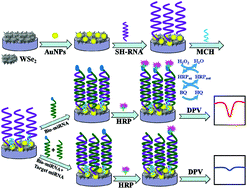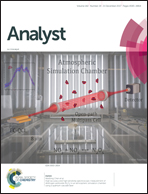An electrochemical microRNA sensing platform based on tungsten diselenide nanosheets and competitive RNA–RNA hybridization†
Abstract
In this work, we report an ultrasensitive electrochemical biosensor for microRNA-21 (miRNA-21) detection by using a competitive RNA–RNA hybridization configuration. A biotinylated miRNA of the self-same sequence with the target miRNA is mixed with the samples, and allowed competition with the target miRNA for a thiolated RNA probe immobilized onto a tungsten diselenide (WSe2) nanosheet modified electrode. Thereafter the current response is obtained by forming the hybridized biotinylated miRNA with streptavidin–horseradish peroxidase (HRP) conjugates to catalyze the H2O2 + hydroquinone (HQ) system. Benefiting from the high specific surface area of WSe2 nanosheets, the competitive hybridization configuration and the signal amplification of the H2O2 + HQ detection system, the proposed assay exhibits a wide linear range of 0.0001–100 pM towards target miRNA with a detection limit of 0.06 fM (S/N = 3), and shows excellent discrimination ability for base-mismatched miRNA sequences. Therefore, the designed platform has promising prospects for the detection of miRNA in biomedical research and early clinical diagnosis.



 Please wait while we load your content...
Please wait while we load your content...